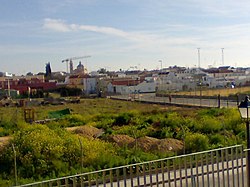You can help expand this article with text translated from the corresponding article in Spanish. (December 2009)Click [show] for important translation instructions.
|
Umbrete, Spain | |
|---|---|
 | |
 | |
| Coordinates: 37°22′N6°09′W / 37.367°N 6.150°W | |
| Country | Spain |
| Province | Seville |
| Municipality | Umbrete |
| Area | |
• Total | 12 km2 (5 sq mi) |
| Elevation | 121 m (397 ft) |
| Population (2018) [1] | |
• Total | 8,768 |
| • Density | 730/km2 (1,900/sq mi) |
| Time zone | UTC+1 (CET) |
| • Summer (DST) | UTC+2 (CEST) |
Umbrete is a city located in the province of Seville, Spain. According to the 2005 census (INE), the city has a population of 5,797 inhabitants.

